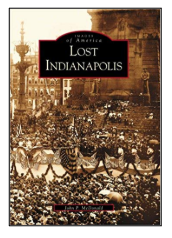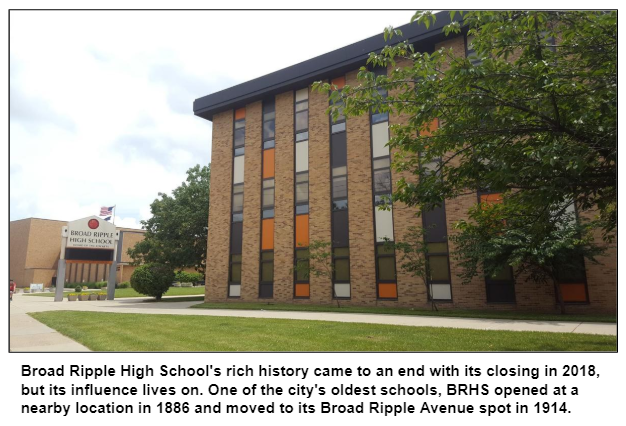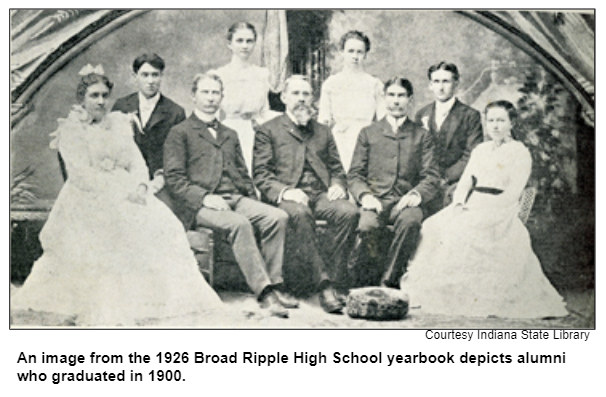
Saturdays, noon to 1 p.m. ET on WICR 88.7 FM.
Or listen live from anywhere on WICR Online!
Our call-in number during the show: (317) 788-3314
July 13, 2019
White River history
During the 1820s, it was a key factor in determining the site of the new city of Indianapolis. But there was a major misconception that became obvious when a steamboat got stuck and became the object of ridicule.
Soon it became an aquatic dumping ground, with complaints about pollution surfacing by the 1880s in both Marion and Hamilton Counties. During the early 1900s, it was the setting for baptism events that involved hundreds of people on Sundays; the practice ended because of typhoid outbreaks.
In the mid-1970s, an Indianapolis-based rock music radio station sponsored hippie-oriented raft races in which competitors paddled aboard discarded sofas, debris and other makeshift watercraft.
In recent decades, however, significant efforts have been undertaken to clean up the White River.

- Kevin Hardie, executive director of the Friends of the White River, who has been involved with the nonprofit since its inception in 1985. His staff role was created in 1999 after a controversial fish kill episode made national news; a chemical discharge from a manufacturing plant in Anderson was blamed for killing as many as 5 million fish.
- Hamilton County historian David Heighway, who has written blog posts about a wide range of aspects of White River history that have had an impact on residents of Noblesville and other nearby towns. The White River was used as a power source by grist mills and other businesses from the earliest eras of the communities, according to David. His research even has uncovered newspaper accounts in 1892 that describe sightings of a Loch Ness-style monster in the river.
- And Alex Umlauf, co-chair of the White River committee of Reconnecting to Our Waterways (ROW) and a former staff member of White River State Park. Both Kevin and Alex conduct on-water tours of the White River.
Assumptions that the White River would be navigable as a major trade route were a significant factor when state leaders in the 1820s selected the site of the Indiana's new capital city.

The humiliating episode, known as Hanna's Folly, convinced Hoosiers that the river could not handle large ships of any kind.
Near the river's edge just west of downtown Indianapolis, Kingan & Co. opened a huge meat-packing operation in the late 19th century; environmentalists eventually criticized the operation and other industries for using the river as a way to dispose of waste.
"As late as the 1950s, state environmental employees sampling the river using a rowboat would have animal entrails hanging from the oars while there were on the river downtown," according to our guest Kevin Hardie.
Colorful watercraft were seen on the White River during the WNAP Raft Races that began in July 1974 and drew thousands of spectators to Broad Ripple Park. Organized by the former WNAP-FM, a radio station popular with young listeners, the raft races were described as "Central Indiana's version of Woodstock."
The White River Vision Plan has been put together to guide decision-making for the next 30 years. According to a recent story published in the Indianapolis Business Journal, the plan encourages the creation of seven recreational "anchor areas" on 58 miles of the White River through Marion and Hamilton counties.
Roadtrip: Yount Mill in Montgomery County
Guest Roadtripper Ron Morris, author and history professor at Ball State University, invites us to join him on a visit to Yount Mill in Montgomery County to learn about industrial history in rural areas of Indiana and the role manufacturing played in the lives of early immigrants to the state.
Ron tells us that the Yount Woolen Mill was founded during Indiana's pioneer period by German immigrants and employed workers from the surrounding area, some of them immigrants from Great Britain. For three generations in the second half of the 19th century, the mill prospered, employing up to 300 millworkers who used the hydraulic power of Sugar Creek to manufacture raw wool fleece into yarn, cloth and clothing.
Some of the wool that passed through Yount Mill ended up in the blankets and uniforms of the men who fought in the American Civil War and the Spanish-American War.The mill's days of prosperity were numbered, however. As Ron explains, the Industrial Revolution that marked the late 19th century brought changes in global trade and technological innovation that rendered Yount Mill unable to compete. It ceased production in 1905.
Today, Yount Mill lives on as a site for historic education and a fun weekend getaway. Near the original mill building, the large brick house where the mill owner housed his family has been made into a bed & breakfast, Yountsville Mill & Inn, providing an ideal base camp for those exploring this unique corner of Hoosier history.More information will be available in the Ron's upcoming book, Yountsville: The Rise and Decline of an Indiana Mill Town.
History Mystery
During the early 1900s, a spectacular amusement park flourished on the banks of the White River in the Broad Ripple neighborhood of Indianapolis.
The amusement park opened in 1906 with attractions that included roller coasters, a funhouse, a merry-go-round, a dancing pavilion, marching bands, animal acts, acrobats and rides with such names as Shoot-the-Chutes, Loop-the-Loop and Bump-the-Bumps. Aquatic activities included boat rides on the White River.
Alas, the amusement park was short-lived, destroyed by a massive fire in 1908. The inferno apparently started in an attraction called the Mystic Cave. In 1922, a new entertainment center on the site opened with the name Broad Ripple Amusement Park. It lasted until 1945, when the site was converted into a city park.
Question: What was the name of the original amusement park on the White River in Broad Ripple?
Please do not call in to the show until you hear Nelson pose the question on the air, and please do not try to win if you have won any other prize on WICR during the last two months. You must be willing to give your first name to our engineer, you must answer the question correctly on the air and you must be willing to give your mailing address to our engineer so we can mail the prize pack to you. The prizes this week are a Family 4-Pack to the Indiana State Museum, courtesy of the Indiana State Museum, and a gift certificate to Story Inn in Brown County, courtesy of Story Inn.
Nelson Price, host and historian
Molly Head, producer/project manager, (317) 927-9101
Michael Armbruster, associate producer
Cheryl Lamb, administrative manager
Richard Sullivan, senior tech consultant
Pam Fraizer, graphic designer
Garry Chilluffo, special events consultant
Please tell our sponsors that you appreciate their support!

 Acknowledgments to Monomedia, Visit Indy, WICR-FM, Fraizer Designs, Heritage Photo & Research Services, Henri Pensis, Aaron Duvall, Chloe Tyson, and many other individuals and organizations. We are independently produced and are self-supporting through organizational sponsorship and through individual contribution at the yellow button on our newsletter or website. For organizational sponsorship, which includes logos, links, and voiced credits in the show, contact Molly Head at (317) 927-9101 or email her at molly@hoosierhistorylive.org. Our media reach continues to grow via podcasting and iTunes.
Acknowledgments to Monomedia, Visit Indy, WICR-FM, Fraizer Designs, Heritage Photo & Research Services, Henri Pensis, Aaron Duvall, Chloe Tyson, and many other individuals and organizations. We are independently produced and are self-supporting through organizational sponsorship and through individual contribution at the yellow button on our newsletter or website. For organizational sponsorship, which includes logos, links, and voiced credits in the show, contact Molly Head at (317) 927-9101 or email her at molly@hoosierhistorylive.org. Our media reach continues to grow via podcasting and iTunes.
Thank you!
We'd like to thank the following recent, new and renewal contributors whose donations help make this show possible!
- Perry and Melanie Hammock
- Jim and Bonnie Carter
- Barbara and Michael Homoya
- Noraleen Young
- Barbara Wellnitz
- Phil and Pam Brooks
- Russ Pulliam
- Roz Wolen
- Marion Wolen
- Richard Vonnegut
- Robin Jarrett
July 20, 2019- coming up
Broad Ripple High School history

But there's no questioning the high school has a rich history that sometimes seems to have changed course with the speed of a Rocket, which was adopted as the school's mascot in the early 1930s, according to the Broad Ripple High School Alumni Association.
It was considered a "rural" high school - located in the village of Broad Ripple - when Broad Ripple High opened in 1886 with seven students in a building that also was being used as an elementary school.
It became part of the Indianapolis Public Schools system in 1923 (one year after the village was annexed into the city) and has a roster of notable alumni including David Letterman (class of '65); attorney Marilyn Tucker Quayle (class of '67), the nation's second lady as the wife of former Vice President Dan Quayle, and George Hill (class of 2004), the current NBA player for the Cleveland Cavaliers.
Hoosier History Live will take a glance at the lives of these alumni as we explore how their alma mater evolved from rural to suburban to urban over the years, with plenty of triumphs and challenges along the way. BRHS milestones have included a state high school basketball championship in 1980; court-ordered integration in the 1970s; designation as an Arts and Humanities magnet school; and dwindling enrollment after reaching a peak of 2,500 students in 1995 because of the closings then of other IPS high schools.
Nelson's studio guests will include two alums of Broad Ripple High:
- Alice Ashby Roettger (class of '52), a Broad Ripple historian who has lived in the area most of her life. Members of her family attended the high school for a span of more than 50 years, extending from 1936 (an older sibling was in that class) to 1988, with the graduation of the youngest of her four daughters, all of whom attended Broad Ripple.
- Bruce Buchanan (class of '73), CEO of Buchanan Group Inc./Flanner and Buchanan Funeral Centers and a civic leader. Bruce, who was a member of the high school's state championship tennis team in 1973, is currently involved in an effort to ensure that the school's archives, keepsakes and other artifacts are protected and not dispersed, which has been the fate at some other local high schools that have been closed.
At the 1893 Chicago World’s Fair, the then-new Broad Ripple High School was recognized as one of the nation's outstanding "rural" high schools. At that point in its history, the school was not located at its current address on the corner of Broad Ripple Avenue and Haverford Avenue, where it moved in 1914.
What we know today as Broad Ripple High school consists of a series of additions to the1914 structure, which was itself demolished in 1968. That demolition and reconfiguration project made navigating the school's hallways easier, but getting from one side of the building to the other could still be a circuitous challenge.
Before that demolition, students included Michael Graves (class of '52), an internationally acclaimed architect whose hometown projects included the Indianapolis Art Center near his alma mater; John Mutz (class of '53), former lieutenant governor of Indiana; and former Indianapolis Mayor Steve Goldsmith (class of '64).
Some other BRHS history facts:
- A cow pasture south of the school became its football field in 1928. The parents of an alum killed during World War II donated funds to make Broad Ripple the first IPS school with a lighted football field, according to the alumni association.
- In 1970, the high school was overseen by a black principal, William Jones, for the first time.
- Our guest Bruce Buchanan wrote for The Riparian, the school's newspaper, which, along with the yearbook, won several national awards in the decades following their debuts during the 1920s. Other Riparian staffers included David Letterman's younger sister, Gretchen Letterman, who has enjoyed a long career as a newspaper editor based in St. Petersburg, Fla.
© 2019 Hoosier History Live. All rights reserved.
|










